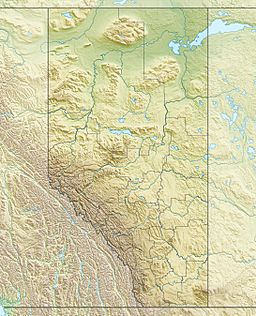Epaulette Mountain facts for kids
Quick facts for kids Epaulette Mountain |
|
|---|---|

Epaulette Mountain seen from Icefields Parkway
|
|
| Highest point | |
| Elevation | 3,094 m (10,151 ft) |
| Prominence | 259 m (850 ft) |
| Parent peak | Mount Chephren (3274 m) |
| Listing | Mountains of Alberta |
| Geography | |
| Location | Alberta, Canada |
| Parent range | Waputik Mountains Canadian Rockies |
| Topo map | NTS 82N15 |
| Geology | |
| Age of rock | Cambrian |
| Type of rock | Sedimentary |
| Climbing | |
| First ascent | 1924 by F.V. Field, W.O. Field, Edward Feuz Jr.(guide) |
| Easiest route | technical climb |
Epaulette Mountain is a tall mountain in Banff National Park, Alberta, Canada. It stands about 3,094 meters (10,151 feet) high. You can find it between the Howse River valley and Mistaya River valley. The mountain's name comes from a French word, epaulette, which means "little shoulders." This is because a glacier on the mountain looks like a shoulder ornament, similar to those on some military uniforms.
Mountain History
The first time someone successfully climbed Epaulette Mountain was in 1924. The climbers were F.V. Field, W.O. Field, and their guide, Edward Feuz Jr. The mountain's name became official in 1961. This was decided by the Geographical Names Board of Canada.
How the Mountain Formed
Like other mountains in Banff National Park, Epaulette Mountain is made of sedimentary rock. This type of rock forms from layers of sand, mud, and tiny bits of plants and animals that settle over millions of years. These layers were laid down during ancient times, from the Precambrian to the Jurassic periods. Over time, these rocks were pushed up and folded. This happened during a big event called the Laramide orogeny. It caused the rocks to move east and stack on top of younger rock layers.
Weather and Climate
Epaulette Mountain is in a subarctic climate zone. This means it has very cold and snowy winters. The summers are usually mild. Temperatures can drop below -20 °C ( -4 °F). With the wind, it can feel even colder, sometimes below -30 °C (-22 °F). Water from melting snow and rain on Epaulette Mountain flows into the Mistaya River and Howse River. These rivers then join the North Saskatchewan River.
Images for kids




